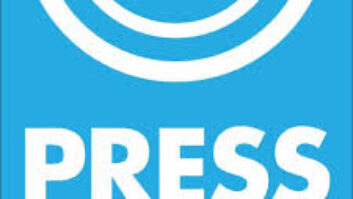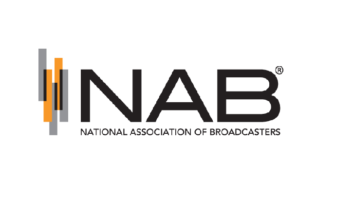(click thumbnail)Fig. 1: A portable scaffold expedites transmitter site construction.Construction supply companies can really come in handy when you’re building a transmitter site. Entercom Scranton’s Lamar Smith and his staff invested in a portable mini-scaffold that set his engineers at just the right height for running the interior plumbing for the transmitters, switches, dummy loads and combiners. The height is adjustable; the wheels will lock in place, so no one takes an unexpected ride.
RF plumbing runs can be executed more quickly than with a stepladder; and the portable scaffold can be helpful when you doing work in the suspended ceiling at the studio location as well. With more home do-it-yourselfers buying things like this, the prices of such construction equipment are dropping. If you don’t have the budget for a tool like this, stop by your local rent-all center and see what’s available.
One of the benefits of this particular portable scaffold is that the upper step serves as a safety bar, running about knee-high. If you’re cutting rigid line, the scaffold does a good job of holding the line while you saw it. Just be sure to wrap the piece in a rubber sheet, mat or cloth so the aluminum scaffolding doesn’t mar or scratch the copper.
Fig. 2 shows a part of the finished plumbing run and cable tray that the scaffold expedited.
Lamar Smith can be reached at [email protected].
(click thumbnail)Fig. 2: Installing RF plumbing is a breeze using the portable scaffold.


. . .
It’s really the little things that can make a construction project proceed smoothly. Lamar’s “find” of the portable scaffold is one example; Ed Bukont’s unique use of a PanaVise is another.
Ed was one of my chief engineers during my contract engineering days, always ready with a better, more efficient way of doing things. His company, Commstruction Services, handles a variety of planning, construction and installation projects. He puts to good use his recent degree in project management; Ed’s attention to detail can be found in the major projects his company handles, and in Fig. 3, where he’s adapted a PanaVise to a transmitter.
(click thumbnail)Fig. 3: Use the rack screw holes to hold a PanaVise or easier wiring.
Mounting the PanaVise or other brand of precision vise to a transmitter or rack will assist with wiring connectors in place, when they could not be preassembled before installation to the equipment. In the case of remote control wiring – control, status and metering – it’s easier to run the multipair cable into the transmitter, and wire the connector “inside” the rig.
The alternative would be to pre-wire the WAGO connector but risk breaking the connector, pins or wires as it is pulled through the chassis to the transmitter. The vise lets you clamp the connector in place, and frees your hands to operate the insertion tool and handle the wire at the same time.
Some transmitters now have 10/32 rack hardware to hold their covers in place, so you can put a 10/32 (or 12/24 if applicable) rack screw thru the Panavise(r) mounting holes, and into the rack or transmitter frame to hold the vise in place.
The photo in Fig. 3 was taken at WFAX(AM) in Falls Church, Va. There, Ed and his company assisted with the installation of a Harris DAX-6. The interface to the outside world on this transmitter uses WAGO connectors, seen connected to the transmitter after the wires were inserted using this method.
This upgrade at WFAX has particular meaning for me; it’s where I started in broadcasting back in 1969 as a summer relief announcer. My contract engineering business partner, Henry Stewart, is still the chief; the program director who hired me, Roy Martin, still works there.
Like many AMs, the station is upgrading with a transmitter capable of transmitting HD Radio. The previous transmitter, a 5 kW Collins, was sold to the station by Clarence Beverage, now a telecommunications consultant. Clarence and Laura Mizrahi now run Communications Technology.
Ed Bukont can be reached at [email protected].

. . .
Sandy Haynes’ broadcast career began a little over a decade earlier than mine, also in front of a microphone, back in 1957. Sandy started at an AM station in Presque Isle, Maine. Sandy wrote to comment on Jess Meyer’s tutorial on RCA connectors in our July 14 column, which he says was well done. Thanks again, Jess!
After a broadcasting career that spanned over 40 years, Sandy wanted to add his two cents’ worth. Sandy feels that one of the major problems newcomers are having with the RCA type or any other connector that requires soldering.
Fortunately, Sandy was able to learn soldering at a young age, mostly by building Heathkits in high school. Heath was renowned for its excellent instruction manuals and gave soldering advice as necessary.
Sandy suggests that beginners invest in a good soldering iron, Ersin brand or other multicore solder, and a dampened sponge to keep the tip clean. For connectors, Sandy usually used a thermostatically controlled iron with an 800-degree tip. After the iron is up to temperature, clean the tip on the sponge and immediately apply a small amount of solder to the tip. This will permit much better heat transfer to your work than a bare tip.
Strip the minimal amount of insulation necessary and tin the wire by applying the iron and a little more solder, which will melt and flow into the wire strands.
At this point you may be able to cut a little of the wire off, as the insulation may shrink after being heated. Some types of insulation are more susceptible to shrinkage than others, and some just downright melt no matter how careful you are.
If you are working with XLR or other connectors with a solder-cup type of connection, be sure to flow solder into the cup and just about fill it up before soldering the wire to the cup. Heat the cup and insert your pre-tinned wire; you will have a good connection.
When attaching RCA or other connectors with a hollow contact, apply heat to the end of the contact, with the tinned wire already inserted. The loose end can be bent over to hold the wire in place as you solder. While you are heating the tip of the hollow contact, feed solder into the hole at the end of the contact. The solder will flow into the pin and make a good secure connection. Then just take a pair of sharp dikes and trim up the end of the pin to remove the excess wire and solder.
Enter the PanaVise again! A small bench-type vise is invaluable when working on most any type of connector and to hold wire for tinning. Here’s a neat idea when working on XLRs. Sandy usually clamps a connector of the opposite sex into the vise and plugs in the connector he’s working on. This method keeps the connector secure.
Always work with a clean iron. Before applying the soldering iron to anything, clean the tip on the sponge, apply a little solder to the tip and then apply the iron to your work. Those three steps should be accomplished in short order. If they can’t be, it’s back to step one. You can’t keep a tip too clean.
Then practice, practice, practice.
Sandy Haynes can be reached at [email protected]. Send us your idea!
Submissions for this column are encouraged, and qualify for SBE recertification credit.











